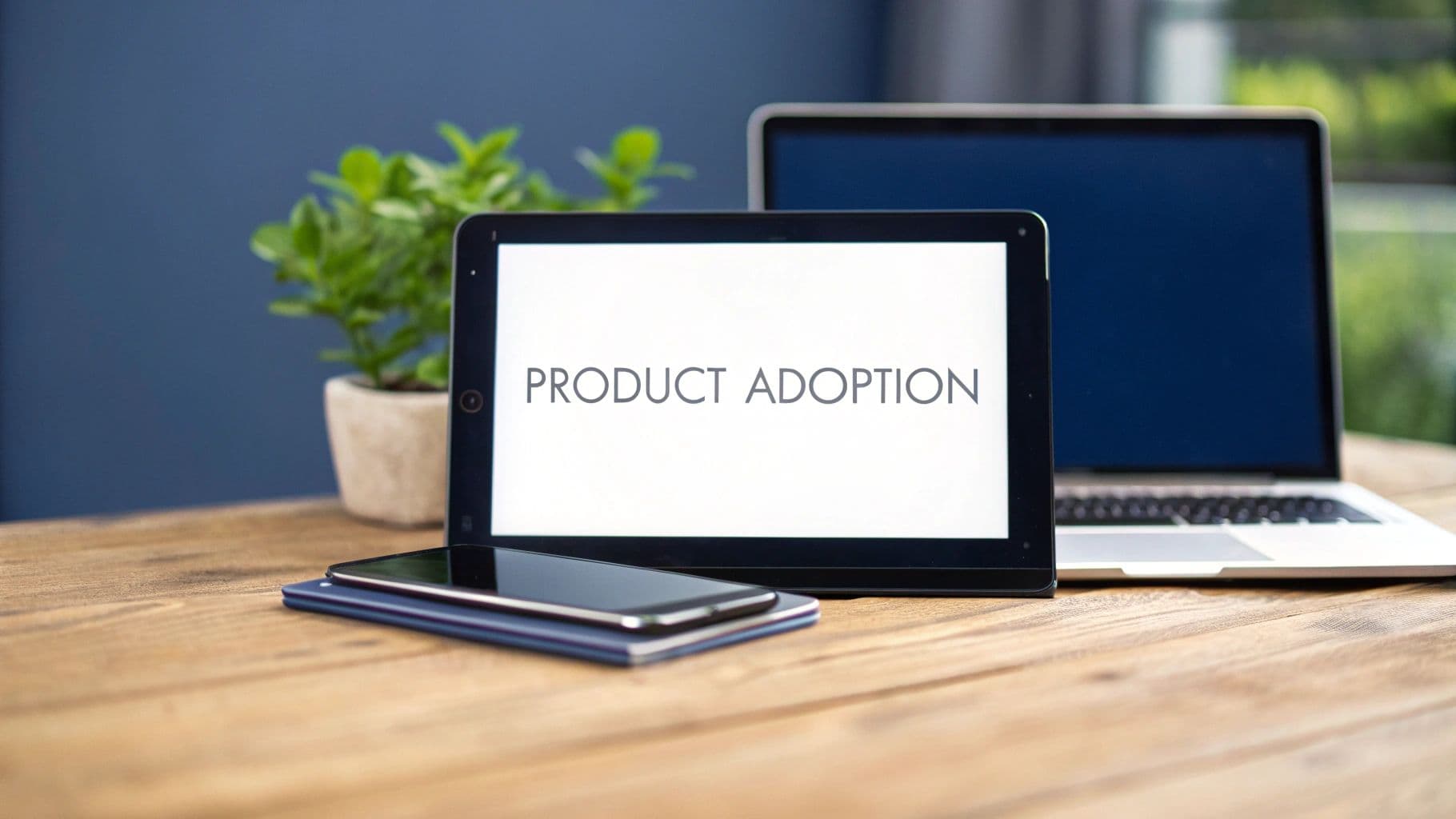How to Reduce Customer Churn with AI
Learn how to reduce customer churn with proven AI strategies. This guide provides an actionable framework to identify at-risk customers and improve retention.

If you want to get serious about reducing churn, you have to stop reacting to lost accounts and start getting ahead of the problem. That means digging in to find the real reasons customers are leaving and using that data to build a better experience from the ground up.
Why Customer Churn Is a Silent Business Killer
Too many companies treat churn like it's just another number on a spreadsheet—the cost of doing business. But that view completely misses the compounding damage it does over time. Even a small monthly churn rate can snowball into a massive hole in your annual revenue, quietly draining your company's growth potential.
Losing a customer isn't just about the subscription fee you won't get next month. It's a much bigger, more complicated problem with a lot of hidden costs. Every person who walks away takes their future revenue with them, along with any friends they might have referred or the positive things they could have said about your brand. This kicks off a nasty cycle where you're forced to spend more and more on expensive customer acquisition, all just to keep your numbers from sliding backward.
The True Cost of a Lost Customer
The hit from churn goes way deeper than immediate revenue. It slowly chips away at your brand's reputation and tanks the overall customer lifetime value (CLV) you’ve worked so hard to build. When you look at the bigger picture, the financial fallout is staggering.
Bad experiences are almost always the culprit. Think about it: research shows that 67% of consumers are willing to jump to a competitor after just one poor experience. And it gets worse. Around 59% of U.S. customers will ditch a brand after a few bad interactions, while a shocking 17% will leave after only one. You can dig into more retention statistics and their business impact to see just how common this is.
Unpacking the Hidden Financial Drain
The damage from a lost customer ripples out in ways you might not expect. To really understand why retention is so crucial, you have to look at all the secondary costs that eat away at your profitability:
- Wasted Acquisition Costs: All the marketing and sales dollars you spent to win that customer? Gone. It’s now a sunk cost with zero future ROI.
- Reduced Employee Morale: Nothing burns out a customer success team faster than constantly dealing with unhappy, departing customers. High churn can lead to frustration, burnout, and even higher employee turnover.
- Negative Word-of-Mouth: An unhappy customer is far more likely to vent about their bad experience than a happy one is to praise you. They can actively turn potential new customers away from your brand.
Making a real effort to reduce customer churn isn't just playing defense. It's one of the smartest growth strategies you can have. It protects your revenue, strengthens your brand, and builds a much more stable foundation for long-term success.
Pinpointing Why Your Customers Are Actually Leaving
You can't fix a problem you don’t truly understand. To get a real handle on churn, you have to move past assumptions and dig into the actual reasons customers are walking away. This isn't just about looking at a single dashboard; it’s about blending hard numbers with real human feedback to see the complete picture.
The first part of the puzzle is your quantitative data—the measurable stuff. Think product usage stats, engagement scores, and the number of support tickets filed. You're looking for the breadcrumbs left behind. Are churning customers using a specific feature far less than your power users? Do they all seem to stop logging in a couple of weeks before they finally cancel? These patterns are your early warning signs.
This data is gold for figuring out the "what" and "when" of churn. It shows you where the cracks start to appear in the customer journey.

As you can see, things like a dip in usage or a pile of unresolved support tickets are often the first measurable signs that a customer is losing faith.
The Human Story Behind the Numbers
While the data tells you what is happening, the qualitative insights explain why. This is where you connect with the real human experience. You need to gather direct feedback to truly understand the frustrations and unmet needs that push a customer to click "cancel."
So, how do you get these stories? Here are a few solid methods:
- Exit Surveys: Keep it simple. Ask one or two direct questions right when they cancel, like, "What was the primary reason you decided to leave?"
- Customer Interviews: Don't be afraid to reach out to recently churned customers for a quick chat. Offering a small incentive, like a gift card, makes a huge difference in how many people are willing to talk.
- Support Ticket Deep Dive: Go beyond just counting tickets. Actually read the transcripts. You'll quickly spot common themes of frustration, confusion, or disappointment.
When you marry these two types of data, you can build a detailed "churn profile" that's unique to your business. For instance, you might discover that users who skip a key onboarding step are 70% more likely to churn within 90 days. That’s a powerful, actionable insight you can only get by connecting behavior with feedback.
Why Every Percentage Point Matters
Getting a handle on these drivers is urgent. Even a small monthly churn rate can have a devastating ripple effect on your business over time. A seemingly small monthly churn of 5% balloons into losing nearly 46% of your customers over a year. Even worse, if your monthly churn hits 10%, you’re on track to lose over 70% of your customers annually.
This table breaks down some common churn drivers and shows you how to connect your data signals with real-world feedback to find your first actionable step.
Decoding Your Churn Signals
| Churn Driver | Key Data Signal (Quantitative) | Common Feedback Theme (Qualitative) | Your First Actionable Step |
|---|---|---|---|
| Poor Onboarding | Low completion rate of setup tasks; no key feature adoption within the first 7 days. | "I was confused and didn't know where to start." | Revamp your welcome email series to include a "first-step" video tutorial. |
| Product Bugs/Glitches | Spike in support tickets related to a specific feature; repeated error logs for a user cohort. | "The app kept crashing whenever I tried to export my data." | Prioritize a bug fix in your next sprint and communicate the update to affected users. |
| Missing Features | Users frequently visit competitor websites (via analytics); low usage of existing "advanced" features. | "I needed X feature to do my job, and you don't offer it." | Create a public feature request board to gauge demand and manage expectations. |
| Lack of Perceived Value | Steady decline in daily/weekly logins; user isn't accessing core value-driving features. | "I just wasn't using it enough to justify the price." | Launch an email campaign highlighting an underused feature that solves a key pain point. |
This kind of analysis forms the bedrock of any successful strategy to reduce customer churn. By identifying not just who is leaving but precisely why, you can shift from putting out fires to proactively building a better customer experience. The next step is using this knowledge to predict who is at risk—before they even think about leaving.
Using AI to Predict Churn Before It Happens
This is where your whole strategy to reduce customer churn flips from reactive to proactive. Instead of digging through data to figure out why a customer left last month, you start identifying who’s likely to walk away next month. This powerful shift is all thanks to artificial intelligence and machine learning, which can pick up on subtle behavioral patterns that are completely invisible to the human eye.
The concept isn’t as complicated as it sounds. Predictive AI models essentially learn what a "high-risk" customer looks like for your business by studying all your historical data. Think of it like a detective building a profile. The AI sifts through thousands of data points to find the common threads that connect customers who’ve already churned.
This process transforms your retention efforts from a guessing game into a data-driven science.

Fueling the AI Engine with the Right Data
An AI model is only as smart as the data it’s fed. To get accurate churn predictions, you have to give it the right mix of behavioral and contextual information. The goal is to provide the AI with a complete 360-degree view of each customer’s journey and how engaged they truly are.
Here are the essential data inputs that really power an effective churn prediction model:
- Product Usage Metrics: This is huge. How often a customer logs in, which features they use most (and which they ignore), and how long their sessions last are all potent indicators. A sudden drop-off is a classic warning sign.
- Support Interaction Data: Look at the volume of support tickets, resolution times, and—this is critical—the sentiment of those conversations. A customer with a growing pile of unresolved, negative tickets is a clear flight risk.
- Subscription and Billing Information: Details like how long they’ve been a customer, any recent plan downgrades, or even failed payments can signal a wavering commitment or financial trouble.
- Direct Customer Feedback: This includes everything from Net Promoter Score (NPS) results and survey responses to notes from your customer success team's calls. Low scores or negative comments are direct cries for help.
When you bring these data streams together, the AI can assign a churn risk score to every single customer. This lets your team laser-focus its energy on the accounts that need it most. If you want to dive deeper into the nuts and bolts, you can explore detailed guides on building effective churn prediction models.
A Practical Scenario of Predictive Churn Prevention
Let's walk through what this looks like in the real world. Imagine you run a B2B project management software company, and your AI model is constantly crunching user data.
On a Monday morning, the system flags a high-value account, "Innovate Corp," with a churn risk score that has shot up from 25% to 75% in just one week.
Instead of waiting for the dreaded cancellation email, your customer success manager, Sarah, gets an immediate notification. She doesn't just see a red flag; she sees the data behind it. This allows for a swift and truly personal intervention.
Sarah reaches out to her contact at Innovate Corp, but not with a generic "just checking in" email. She sends a specific, helpful offer: "I noticed your team hasn't been using the new advanced reporting suite. We're running a 20-minute masterclass on Thursday that shows how to cut reporting time in half. Can I sign your team up?"
The contact says yes. The training session solves a hidden frustration, gets them re-engaged with the product, and reminds them of its value. The account is saved—not with a last-ditch discount, but because AI provided the foresight to act proactively. This is the new frontier in the effort to reduce customer churn.
Putting Your AI Churn Predictions into Action
Having AI-powered predictions is like getting a weather forecast for your customer base—it's a powerful warning that a storm is brewing. But a forecast is useless if you don't act on it. Now it’s time to build the shelter. This is where you turn those predictive insights into targeted, automated actions that actually reduce customer churn.
The whole point is to move past the tired, last-ditch "10% off" emails and start launching intelligent interventions that add real value.
These interventions are often called "retention plays." Think of them as pre-planned workflows that kick in automatically when an AI model flags a customer's churn risk score crossing a certain line. Instead of a one-size-fits-all scramble, each play is designed to address the specific reason a customer is at risk. This is the big leap from being reactive to proactive, and it's what truly separates high-growth companies from everyone else.
From Prediction to Personalized Action
Let's make this real. Imagine your AI flags a user whose engagement with a key analytics feature has cratered by 50% in the last two weeks. A generic "we miss you" email is just noise; it does nothing to solve their problem.
A smart retention play, on the other hand, would trigger a highly specific, automated action.
The system could, for example, instantly send an email with a short video tutorial on that exact feature. Maybe it includes a link to a case study showing how a similar company used it to get fantastic results. This isn't a sales pitch. It's a helping hand that directly addresses why they've disengaged in the first place.
Here are a few more practical examples of what these AI-driven plays look like:
- Low Feature Adoption: An in-app message pops up offering a guided tour or an invite to a quick, on-demand webinar for the feature they're ignoring.
- Declining Login Frequency: The system sends a personalized email with a "quick win" tip sheet, showing the user how to get something valuable done in less than five minutes.
- Negative Support Sentiment: A task is automatically created for a customer success manager to personally call that user, armed with the full context from their frustrating support ticket.
The Power of Proactive Feedback Loops
Keeping a pulse on customer feedback is just as critical. Churn rates aren't uniform; they swing wildly between industries. The wholesale industry, for instance, can see churn rates hit 56%. During the pandemic, consumer packaged goods (CPG) saw their rates jump to 40%, partly because a staggering 76% of consumers were trying new shopping behaviors.
This kind of volatility shows why you need a constant line of communication. It's a strategy companies like Coca-Cola HBC have used to monitor customer feedback and get ahead of problems before they lead to churn. You can see more details on industry-specific churn rates at customergauge.com.
Ultimately, these plays are all about getting the right help to the right customer at exactly the right time. By automating these timely interventions, you don't just save at-risk accounts—you build a more resilient and loyal customer base over the long haul.
Of course, the key is to track which plays actually work. That requires a solid understanding of the right metrics, so be sure to check out our guide on the essential user retention metrics that tell the real story of your customer relationships.
Weaving Retention into Your Customer Experience

The best strategies to reduce customer churn aren't last-ditch efforts; they're baked into your business from day one. While AI-powered predictions are fantastic for flagging at-risk accounts, the real win is weaving retention directly into the fabric of your customer experience. Think of it as building a moat around your business—one filled with incredible service and undeniable value.
When you do this right, your customers become far more resilient to a competitor's flashy offer or a new pricing model. It's a shift from constantly putting out fires to building a strong foundation. Every single interaction, from that first login to the hundredth support ticket, becomes a chance to prove your worth and build a stronger connection. Get the experience right, and the idea of leaving won't even cross their minds.
Nail the First Impression with a Flawless Onboarding
The onboarding process is, without a doubt, the most critical phase of the customer journey. This is where you make good on the promises from your sales team or, conversely, create instant buyer's remorse. A confusing or clunky start is one of the quickest ways to lose a new customer.
Your goal here isn't to just show off a bunch of features. It's about getting that user to their first "aha!" moment as fast as humanly possible. That’s the point where they truly get the value of your product and see how it solves their problem. It's no surprise that 68% of users are more likely to stick around when a business delivers great onboarding and education.
Here are a few ways I’ve seen this done effectively:
- Create Role-Based Welcome Flows: Don't throw every new user into the same generic tour. An admin setting up the entire account has very different needs than an end-user who will only ever use one specific feature. Tailor the experience.
- Use Interactive Walkthroughs: Forget those long, passive video tutorials. In-app guides that prompt users to actually do the key actions are far more effective. They build muscle memory and confidence right away.
- Define and Celebrate a "First Win": Figure out what a successful first session looks like for your user and guide them straight to it. A simple in-app message or a quick congratulatory email celebrating that milestone goes a long way.
Provide Effortless, Omnichannel Support
When a customer hits a snag, how you respond can make or break the entire relationship. It's startling, but some research suggests that as much as 85% of churn is due to poor customer service—not problems with the product or the price. A single terrible support interaction can undo months of hard work.
Building a support system that actually creates loyalty means being available wherever your customers are and offering consistent, quality help on every channel.
To really elevate your support, you have to think seamlessly. The context from a live chat conversation needs to carry over if that chat becomes a follow-up email. Customers shouldn't have to repeat their story five times. Give your support agents a complete picture of the customer's history—onboarding status, past tickets, product usage. This context is what turns a generic, scripted reply into a personalized solution that makes your customer feel heard and valued.
Your Questions on AI and Churn Reduction Answered
Whenever I talk to teams about bringing AI into their retention strategy, a few key questions always come up. It's totally normal to wonder about timelines, what a "good" churn rate even looks like, and just how much technical firepower you really need.
Let's walk through some of the most common uncertainties I see businesses grapple with. Getting these questions answered upfront is crucial for setting realistic expectations and building a retention plan you can actually believe in.
What Is a Good Customer Churn Rate to Aim For?
This is the million-dollar question, and the honest answer is: it depends. There’s no universal magic number for churn. What’s considered "good" is completely tied to your industry, business model, and how long you've been around.
For a fast-growing B2C startup, a 5-7% monthly churn rate might be perfectly acceptable, even expected. But for a mature, enterprise-level SaaS company, anything over 1% a month would likely set off alarm bells.
My advice? Start by looking at your direct competitors to get a feel for the industry benchmark. But more importantly, focus on your own numbers. The real goal isn't to hit an arbitrary percentage, but to create a consistent, downward trend in your churn rate. Progress is what truly matters.
How Soon Can I Expect to See Results From These Strategies?
You'll see results in stages. Some tactics, like a well-timed cancellation offer, can make an impact almost immediately. You could see a bump in your "save" numbers within the first month of launching a play like that. These are the quick, reactive wins.
The bigger, more foundational improvements take a bit more time to bear fruit. Building out proactive AI models and truly overhauling your onboarding experience is a long-term investment.
Do I Need a Data Scientist to Predict Churn With AI?
Not necessarily. A few years ago, the answer would have been a definite "yes," but the game has changed. While a dedicated data scientist can build incredibly complex, custom models, you don't need one to get started.
Many of the customer success and CRM platforms on the market today come with powerful predictive analytics built right in. These tools are designed to democratize AI for retention.
Here’s what they typically handle for you:
- Automatically crunching your existing customer data.
- Generating a clear churn risk score for every single account.
- Visualizing these insights on a straightforward dashboard.
For most businesses, these out-of-the-box solutions are the fastest and most practical way to start using AI to predict churn, no coding required.
At SigOS, we transform your customer feedback into clear, revenue-driving priorities. Our AI platform analyzes support tickets, calls, and usage data to pinpoint exactly which issues are causing churn and which feature requests will unlock growth. Learn how to prioritize your roadmap with confidence.


